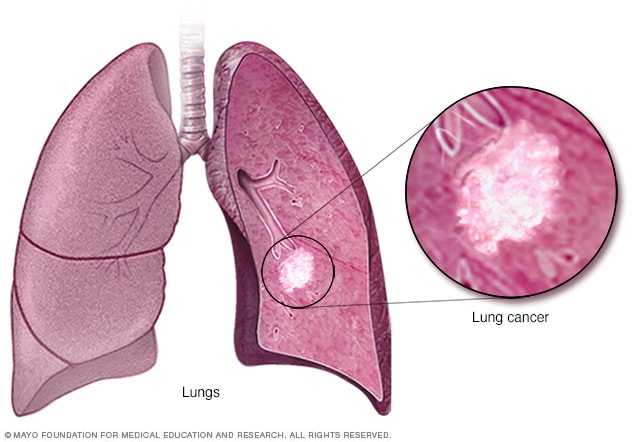概述
肺癌

肺癌是一种始于肺部的癌症。肺是胸部的两个海绵状器官,当您吸气时会吸入氧气,呼气时会呼出二氧化碳。
肺癌是全球癌症死亡的主要原因。
吸烟的人患肺癌的风险最大,不过从不吸烟的人也可能患肺癌。患肺癌的风险随着吸烟的时间和数量的增加而增加。如果您戒烟,即使在抽烟多年后,您患肺癌的几率也可以大大降低。
症状
肺癌在早期阶段通常不会引起体征和症状。肺癌的体征和症状通常出现在疾病晚期。
肺癌的体征和症状可能包括:
- 咳嗽不止
- 咳血(即使是少量)
- 气短
- 胸部疼痛
- 声音嘶哑
- 体重意外下降
- 骨痛
- 头痛
何时就诊
如果有任何持续的体征或症状令您担心,请与医生约诊。
如果您吸烟且一直无法戒烟,请预约医生就诊。医生可能推荐戒烟策略,例如咨询、用药和尼古丁替代产品。
病因
大多数肺癌都是由于吸烟所致,患者不仅有吸烟者,还有接触二手烟的人。但肺癌也见于从未吸烟且从未长时间接触二手烟的人。这些肺癌病例的病因尚不清楚。
抽烟如何导致肺癌
医生认为抽烟会损伤肺部细胞,从而导致肺癌。当您吸入充满致癌物质(致癌物)的香烟烟雾时,肺组织几乎立刻就会发生变化。
一开始您的身体也许能修复这种损伤。但随着每次反复暴露,肺部正常细胞的损伤也越来越严重。随着时间推移,这种损伤会导致细胞行为异常,最终可能发展成癌症。
肺癌类型
医生根据肺癌细胞在显微镜下的外观将肺癌分为两大类。医生会基于您所患肺癌的主要类型来决定治疗方案。
肺癌的两大类型包括:
- 小细胞肺癌。小细胞肺癌几乎只会发生于重度吸烟者,比非小细胞肺癌少见。
- 非小细胞肺癌。非小细胞肺癌是多种肺癌的概括性术语。非小细胞肺癌包括鳞状细胞癌、腺癌和大细胞癌。
风险因素
很多因素会导致患肺癌的风险升高。有些风险因素可以控制,例如戒烟。其他因素则无法控制,比如家族病史。
导致肺癌的风险因素包括:
- 抽烟。每天抽烟数量越多,烟龄越长,则患肺癌的风险就越高。无论在哪个年龄段,戒烟均可显著降低患肺癌的风险。
- 接触二手烟。即使您不抽烟,但如果您会接触到二手烟,那您患肺癌的风险也会升高。
- 曾接受过放射疗法。如果您曾因另一种癌症而接受过胸部放射疗法,您患肺癌的风险可能增加。
- 接触氡气。氡气是泥土、岩石和水中的铀自然分解的一种产物,最终会成为您呼吸的空气的一部分。任何建筑物内都可能积聚危险水平的氡气,包括家中。
- 接触石棉和其他致癌物。在工作场所接触石棉和其他致癌物质(例如砷、铬和镍)会增加患肺癌的风险,尤其是对吸烟者而言。
- 肺癌家族史。如果父母、兄弟姐妹或孩子患肺癌,则本人患肺癌的风险会更高。
Smoking
Your risk of lung cancer increases with the number of cigarettes you smoke each day. Your risk also increases with the number of years you have smoked. Quitting at any age can significantly lower your risk of developing lung cancer.
Exposure to secondhand smoke
Even if you don't smoke, your risk of lung cancer increases if you're around people who are smoking. Breathing the smoke in the air from other people who are smoking is called secondhand smoke.
Previous radiation therapy
If you've had radiation therapy to the chest for another type of cancer, you may have an increased risk of developing lung cancer.
Exposure to radon gas
Radon is produced by the natural breakdown of uranium in soil, rock and water. Radon eventually becomes part of the air you breathe. Unsafe levels of radon can build up in any building, including homes.
Exposure to cancer-causing substances
Workplace exposure to cancer-causing substances, called carcinogens, can increase your risk of developing lung cancer. The risk may be higher if you smoke. Carcinogens linked to lung cancer risk include asbestos, arsenic, chromium and nickel.
Family history of lung cancer
People with a parent, sibling or child with lung cancer have an increased risk of the disease.
并发症
肺癌可导致多种并发症,例如:
- 气短。如果肺癌发展到阻塞主要气道,患者可能气短。肺癌也会导致肺部周围积满液体,使受累的肺在吸气时难以完全扩张。
- 咳血。肺癌会导致气道出血,从而导致咳血(咯血)。有时出血会变得很严重。治疗可以控制出血。
- 疼痛。晚期肺癌扩散到肺内或身体的其他部位(例如骨骼)会引起疼痛。如果您感到疼痛,请告诉医生,因为有许多治疗方法可以控制疼痛。
-
胸内液体(胸腔积液)。肺癌可导致液体在胸腔(胸膜腔)内受累肺周围的空间中积聚。
胸腔积液会导致气短。可通过治疗从胸部排出液体,降低胸腔积液再次发生的风险。
-
癌症扩散至身体其他部位(转移)。肺癌往往会扩散(转移)到身体的其他部位,例如大脑和骨骼。
癌症扩散可引起疼痛、恶心、头痛或其他症状,具体取决于受累的器官。一旦肺癌扩散到肺部以外,通常无法治愈。治疗可以减少体征和症状,延长存活时间。
Shortness of breath
People with lung cancer can experience shortness of breath if cancer grows to block the major airways. Lung cancer also can cause fluid to collect around the lungs and heart. The fluid makes it harder for the affected lung to expand fully when you inhale.
Coughing up blood
Lung cancer can cause bleeding in the airway. This can cause you to cough up blood. Sometimes bleeding can become severe. Treatments are available to control bleeding.
Pain
Advanced lung cancer that spreads can cause pain. It may spread to the lining of a lung or to another area of the body, such as a bone. Tell your healthcare professional if you experience pain. Many treatments are available to control pain.
Fluid in the chest
Lung cancer can cause fluid to accumulate in the chest, called pleural effusion. The fluid collects in the space that surrounds the affected lung in the chest cavity, called the pleural space.
Pleural effusion can cause shortness of breath. Treatments are available to drain the fluid from your chest. Treatments can reduce the risk that pleural effusion will happen again.
Cancer that spreads to other parts of the body
Lung cancer often spreads to other parts of the body. Lung cancer may spread to the brain and the bones.
Cancer that spreads can cause pain, nausea, headaches or other symptoms depending on what organ is affected. Once lung cancer has spread beyond the lungs, it's generally not curable. Treatments are available to decrease symptoms and to help you live longer.
预防
没有确定的方法可以预防肺癌,但如果您做到以下几点便可以降低风险:
- 请勿抽烟。如果您从未吸烟,请不要开始吸烟。与您的孩子谈论不抽烟,让孩子们了解如何避免这种主要的肺癌风险因素。尽早开始与孩子谈论抽烟的危险,以便他们知道如何应对同侪压力。
- 戒烟。立即戒烟。即使已经吸烟多年,戒烟也能降低患肺癌的风险。与您的医生讨论可以帮助您戒烟的策略和戒烟补助剂。选项包括尼古丁替代产品、用药和互助组。
- 避免二手烟。如果您与吸烟者一起生活或工作,请敦促其戒烟。至少要让其在外面抽烟。避开酒吧和餐馆等人们吸烟的地方,寻找无人吸烟的地方。
- 测试您家中的氡。检查家中氡的水平,尤其是如果您住在已知存在氡问题的地区。氡水平高可通过补救措施使您的房屋更安全。有关氡测试的信息,请联系您当地的公共卫生部门或美国肺脏协会的当地分会。
- 避免在工作中使用致癌物。采取预防措施以防止自己在工作中接触有毒化学物质。请遵循雇主规定的预防措施。例如,如果为您提供了保护口罩,请务必佩戴。询问您的医生您还能采取哪些措施在工作中保护自己。如果吸烟,工作场所致癌物对肺造成伤害的风险会增加。
- 吃富含水果和蔬菜的饮食。选择具有多种水果和蔬菜的健康饮食。最好是选择维生素和营养素的食物来源。避免以药丸形式服用大剂量的维生素,因为这可能有害。例如,研究人员希望减少重度吸烟者患肺癌的风险,因此给他们添加了 β- 胡萝卜素补充剂。结果表明,补充剂实际上增加了吸烟者患癌症的风险。
- 每周多运动。如果您没有定期运动,请慢慢开始。试着每周多抽时间运动。
Don't smoke
If you've never smoked, don't start. Talk to your children about not smoking so that they can understand how to avoid this major risk factor for lung cancer. Begin conversations about the dangers of smoking with your children early so that they know how to react to peer pressure.
Stop smoking
Stop smoking now. Quitting reduces your risk of lung cancer, even if you've smoked for years. Talk to your healthcare team about strategies and aids that can help you quit. Options include nicotine replacement products, medicines and support groups.
Avoid secondhand smoke
If you live or work with a person who smokes, urge them to quit. At the very least, ask them to smoke outside. Avoid areas where people smoke, such as bars. Seek out smoke-free options.
Test your home for radon
Have the radon levels in your home checked, especially if you live in an area where radon is known to be a problem. High radon levels can be fixed to make your home safer. Radon test kits are often sold at hardware stores and can be purchased online. For more information on radon testing, contact your local department of public health.
Avoid carcinogens at work
Take precautions to protect yourself from exposure to toxic chemicals at work. Follow your employer's precautions. For instance, if you're given a face mask for protection, always wear it. Ask your healthcare professional what more you can do to protect yourself at work. Your risk of lung damage from workplace carcinogens increases if you smoke.
Eat a diet full of fruits and vegetables
Choose a healthy diet with a variety of fruits and vegetables. Food sources of vitamins and nutrients are best. Avoid taking large doses of vitamins in pill form, as they may be harmful. For instance, researchers hoping to reduce the risk of lung cancer in people who smoked heavily gave them beta carotene supplements. Results showed the supplements increased the risk of cancer in people who smoke.
Exercise most days of the week
If you don't exercise regularly, start out slowly. Try to exercise most days of the week.